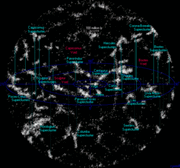Intergalactic space is the physical space between galaxies. Generally free of dust and debris, intergalactic space

The universe within 1 billion light-years (307 Mpc) of Earth, showing local superclusters and voids
is very close to a vacuum. The average density of the Universe is less than one atom per cubic meter. The density of the Universe, however, is clearly not uniform; it ranges from relatively high density in galaxies (including very high density in structures within galaxies, such as planets, stars, and black holes) to extremely rarefied conditions in vast voids that have lower density than the Universe's average.
Surrounding and stretching between galaxies, there is a rarefied gas that is thought to possess a cosmic filamentary structure and that is slightly denser than the average density in the Universe. This material is called the intergalactic medium (IGM) and is mostly ionized hydrogen (i.e. a plasma) consisting of equal numbers of electrons and protons. The IGM is thought to exist at a density of 10 to 100 times the average density of the Universe (10 to 100 hydrogen atoms per cubic meter). It reaches densities as high as 1000 times the average density of the Universe in rich clusters of galaxies.
The reason the IGM is thought to be mostly ionized gas is that its temperature is thought to be quite high by terrestrial standards (though some parts of it are only "warm" by astrophysical standards). As gas falls into the Intergalactic Medium from the voids, it heats up to temperatures of K to K, which is too hot for hydrogen nuclei to retain their electrons. At these temperatures, it is called the Warm-Hot Intergalactic Medium (WHIM). Computer simulations indicate that on the order of half the atomic matter in the universe might exist in this warm-hot, rarefied state. When gas falls from the filamentary structures of the WHIM into the galaxy clusters at the intersections of the cosmic filaments, it can heat up even more, reaching temperatures of K or more.
See also[]
- Intracluster medium
- Interstellar medium
- Heliosphere
- Solar space
- Solar system
- Stellar system
External links[]
- Intergalactic Space, Natural History, Feb 1998


